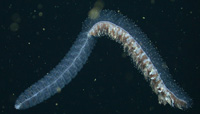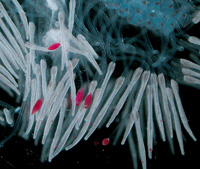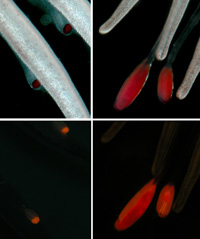 The new species of Erenna, prior to collection. The entire colony is about 30 cm long. The lures are on the lower side of the portion of the colony in the right of the photograph (they are in a retracted state).
The new species of Erenna, prior to collection. The entire colony is about 30 cm long. The lures are on the lower side of the portion of the colony in the right of the photograph (they are in a retracted state).
 Many tentilla, illuminated with white light. Each tentillum has a central axis, which terminates in the red luminescent lure. The nematocysts are in a structure (which appears white and brown) that sheathes this axis.
Many tentilla, illuminated with white light. Each tentillum has a central axis, which terminates in the red luminescent lure. The nematocysts are in a structure (which appears white and brown) that sheathes this axis.
 The lures under different types of illumination. The luminescence is a two part process. In the first, chemical energy is turned into blue light in a structure at the middle of the lure. The bioluminescent lure is surrounded by a red fluorescent material, which absorbs the blue light and reemits the energy as red light. In the bottom row are lures that are illuminated with blue light so that they emit red light (the blue light has been filtered out of the photograph).
The lures under different types of illumination. The luminescence is a two part process. In the first, chemical energy is turned into blue light in a structure at the middle of the lure. The bioluminescent lure is surrounded by a red fluorescent material, which absorbs the blue light and reemits the energy as red light. In the bottom row are lures that are illuminated with blue light so that they emit red light (the blue light has been filtered out of the photograph).
Like other cnidarians, siphonophores capture prey with specialized stinging capsules called nematocysts. These fire small, hollow harpoons that simultaneously anchor prey and inject toxins that immobilize and kill it. Different cnidarians, however, have evolved very different strategies to get potential prey within range of their nematocysts.
Most siphonophores are sit and wait predators- after an active bout of swimming they cast a wide net of tentacles and wait for fish and crustaceans to swim into them. Most of the nematocysts of siphonophores are tightly packed into the side branches of the tentacles, called tentilla. It has previously been hypothesized that the tentilla of some shallow-dwelling species look like small crustaceans when illuminated by the sun, and that they act as lures that attract fish to their nematocysts (Purcell, 1980).
Colonies of many species of siphonophores live only in the deep-sea though, and this leads to a couple of problems when it comes to capturing prey. First, prey are not as abundant as at the surface, so waiting for them to swim into a web of tentacles may not yield enough to eat. Second, there is no sunlight and lures based on shape alone are useless because they cannot be seen.
A new species of deep-sea siphonophore has recently been found off the coast of California that has a surprising strategy for enticing prey to its nematocyst-laden tentilla. Each tentillum has a structure that glows bright red and twitches with a motion characteristic of a copepod, a small crustacean that many fish eat. Some fish in the deep sea look for prey by using their own bioluminescent light sources as headlights, and would be attracted to what appears to it to be a brightly illuminated meal. This new species of siphonophore, which belongs to a group called Erenna, does not cast a wide net of tentacles and instead keeps its tentacles close to the rest of the colony.
This siphonophore is a first to science in several ways.
- It is the first marine invertebrate known to generate red light.
- It is the first non-visual predator known to use luminescent lures.
- It suggests that red light is more important in the deep sea than was previously thought to be the case.
These findings appear in the journal Science:
Haddock, S.H.D., C.W. Dunn, P.R. Pugh. and C.E. Schnitzler. (2005) Bioluminescent and red-fluorescent lures in a deep-sea siphonophore. Science. 309:263.[pdf]
For more information on bioluminescence, please visit the Bioluminescence Web Page.

